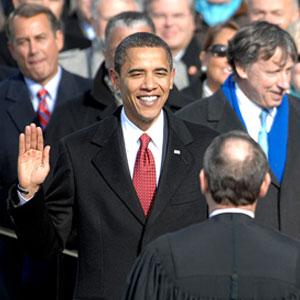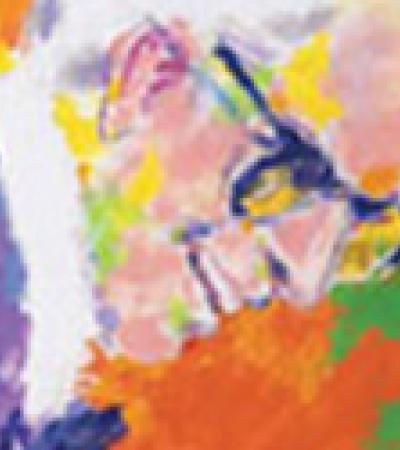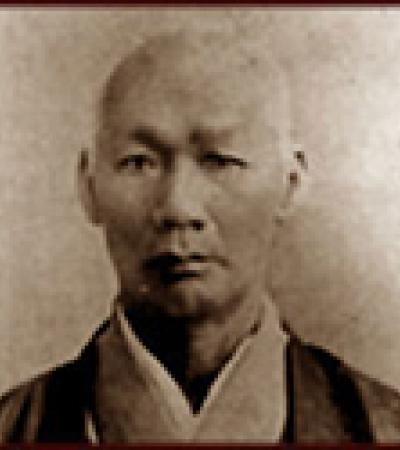This month, EDSITEment looks at the American Presidents, including their inaugural speeches; discusses the Bill of Rights; considers three giants of American literature—Herman Melville, John Steinbeck, and Mark Twain; and celebrates the life of Martin Luther King Jr.
Presidential Inaugurations

Every four years in the third week of January, Pennsylvania Avenue in Washington, D.C., is lined with chilly spectators and red, white, and blue bunting. Americans arrive by the hundreds of thousands to watch the official procession slowly making its way to the Capitol building, where the newly elected or re-elected president will take the oath of office and be sworn in for the next four years. In 2009, record numbers came to witness the swearing in of the first African American president, Barack Obama.
As President Clinton’s former speechwriter Ted Widmer noted, the nation looks forward to the processions and the parades, “the jets streaking overhead, the swearing-in ceremony—and then, of course, the inaugural address, when the most powerful man in the world elucidates his vision for the next four years of history.” While some of these speeches are quickly forgotten, many are worth reading at least in part, and a few are notable works of American literature. Find out more in Presidential Inaugurations: A Capitol Parade on a Cold Winter’s Day.
United States Presidents
American presidents hold the most powerful office on earth and occupy a unique place at the center of national and world events. At once chief executive, head of state, commander-in-chief, and leader of a political party, the President of the United States is also a prominent cultural figure, and a bellwether of the society he governs. Check out the PBS’s American Experience series on the United States Presidents and find related lesson plans and websites on EDSITEment.
The Bill of Rights
The Creation of the Bill of Rights: “Retouching the Canvas” focuses on the arguments either for or against the addition of a Bill of Rights between 1787 and 1789. By examining the views of prominent Americans in original documents, students will see that the issue at the heart of the debate was whether a Bill of Rights was necessary to secure and fulfill the objects of the American Revolution and the principles of the Declaration of Independence. Students will also gain an understanding of the origins of the Bill of Rights and how it came to be part of what Thomas Jefferson called “the American mind,” as well as a greater awareness of the difficulties that proponents had to overcome in order to add the first ten Amendments to the Constitution.
Herman Melville
On January 3, 1841, twenty-one year-old Herman Melville boarded the Acushnet, a New Bedford whaler, heading for the South Seas and the Pacific whaling grounds. He would spend eighteen months on the Acushnet, learning to be a whaler. This would also be his coming-of-age passage and an education. As he later wrote about his character, Ishmael, “… a whale ship was my Yale College and my Harvard.” On this voyage, Melville would take part in all aspects of the hunting, harvesting, and processing of whale oil aboard the ship. He would absorb the lore of the veteran seamen who made up the Acushnet’s diverse and colorful crew. His first-hand experiences on this and several subsequent voyages would percolate to become the basis for his later seafaring novels, most notably his masterpiece, Moby-Dick. Find out more about Melville’s experiences through Pursuing Melville: “A Dead Whale or a Stove Boat.”
John Steinbeck
The historical record of John Steinbeck’s working method that culminated in The Grapes of Wrath includes his accounts of the migrants in the camps gathered through his fieldwork and accompanied by photographic documentation by Dorothea Lange and other national photojournalists. These observations found expression in Steinbeck’s The Harvest Gypsies series of news articles, which served as a seedbed for The Grapes of Wrath. Steinbeck also kept a personal journal with daily entries during the writing of The Grapes of Wrath, later published as Working Days. An examination of The Harvest Gypsies and Working Days provides valuable insight into the author’s mindset and vision as he composed the novel. Find out more in John Steinbeck’s “The Grapes of Wrath”: Verbal Pictures.
Mark Twain
Given Twain’s known penchant for irony, comedy, and satire, some readers have seen “The Man That Corrupted Hadleyburg” as a replay of the Garden of Eden story—recounting the Fall of Hadleyburg, the innocent or virtuous “city on a hill”—and see the source of its corruption—the “Man” of its title—as the incarnation of Satan. In fact, in his hilarious autobiography, Twain himself encourages such a reading. “I have always felt friendly toward Satan,” he confesses. He reports how, as a seven year old, he thought to write a biography of Satan, a project Mr. Barclay, his Sunday School teacher, nipped in the bud. Consider “The Man That Corrupted Hadleyburg” in this Launchpad.



